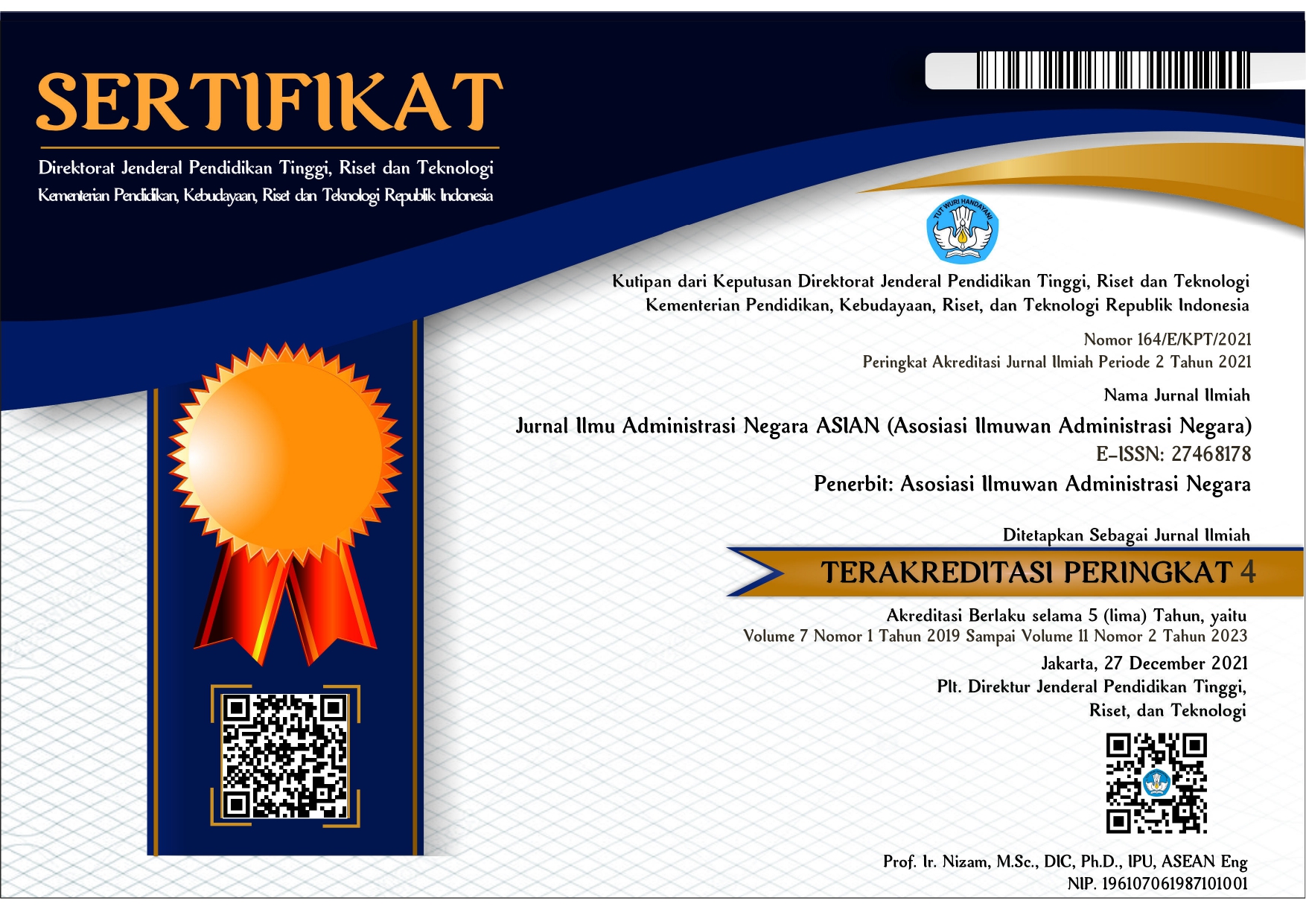Evaluasi Kebijakan Berbasis Responsivitas Terhadap Rencana Kontinjensi Tsunami Provinsi Sumatera Barat
 Abstract views: 394
,
Abstract views: 394
,
 PDF downloads: 428
PDF downloads: 428
Abstract
West Sumatra Province has a high risk of tsunami disaster. From this situation description, an appropriate and relevant Contingency Plan is needed so that it can be used effectively when a disaster occurs. This research explains the evaluation of West Sumatra Province's tsunami contingency planning policy based on the descriptor of public policy responsiveness proposed by William Dunn. The approach used in this research is descriptive qualitative with purposive sampling to determine informants. Meanwhile, the data analysis technique uses the triangulation method. The results of the research show that from the descriptor of the responsiveness of West Sumatra's tsunami contingency plan policy, there is doubt about its readiness to face this disaster. This is because the necessary measures have not gone through a review process to adapt them to the threats and required resource requirements. From the research findings, it can be explained that the responsiveness descriptor, namely focusing on crucial issues and intensity of preferences, has not been implemented in the West Sumatra tsunami contingency plan policy.
Downloads
References
Alhadi, Z., Maani, K. D., Nurhabibi, P., & Syarief, A. (2018). An analysis of problem in composing of tsunami contingency plan in Padang City. In MATEC Web of Conferences (Vol. 229, p. 03007). EDP Sciences.
Arikunto, S. (2010). MetodePenelitian. Jakarta: Bumi Aksara.
Arinaldi, J. (2015). Strengthening provincial role in disaster preparedness: A case study of the Local Agency for Disaster Management at Lampung. Jurnal Ilmiah Administrasi Publik, 1(1), 32-38.
Belford, N. C. (2021). Contingency Planning Amidst a Pandemic. Journal of Cybersecurity Education, Research and Practice, 2021(1), 3.
BNPB. (2008). Perencanaan Kontijensi. Jakarta
Choularton, R. (2007). Contingency planning and humanitarian action: a review of practice.
Dunn, Willian N. (2000) . Pengantar Analisis Kebijakan Publik. Edisi Kedua. Yogyakarta: Gajah Mada University Press
Dunn, Willian N. (2000) . Pengantar Analisis Kebijakan Publik. Edisi Kedua. Yogyakarta: Gajah Mada University Press
Fiorino, D. J. (2010). Sustainability as a conceptual focus for public administration. Public administration review, 70, s78-s88.
Forbes, N. (2009). Contingency planning for earthquakes in Asia. Journal of Business Continuity & Emergency Planning, 3(4), 356-367.
Heath, R. L., & Palenchar, M. J. (2008). Strategic issues management: Organizations and public policy challenges. Sage Publications.
Inkinen, S., Williams, V., & Hoque, W. M. (2021). Effect of Contingency Planning on Survival of the Hotels in California, USA amid COVID 19 pandemic. Journal of Hospitality and Tourism Management, 4(2).
Jones, B. D., & Baumgartner, F. R. (2005). A model of choice for public policy. Journal of public administration research and theory, 15(3), 325-351.
Lestari, F., Pelupessy, D., Jibiki, Y., Putri, F. A., Yurianto, A., Widyaputra, G., ... & Imamura, F. (2018). Analysis of complexities in Natech disaster risk reduction and management: A case study of Cilegon, Indonesia. Journal of Disaster Research, 13(7), 1298-1308.
Lestari, P., Paripurno, E. T., Kusumayudha, S. B., & Nugroho, A. R. B. (2018). Model Of Communication Planning For Contingency Plan Of Disaster Risk Management Sinabung Volcano Eruption.
Lexy, J. Moleong. (2002). Metode penelitian kualitatif. Bandung: Rosda Karya.
Mabaso, E., & Manyena, S. B. (2013). Contingency planning in southern Africa: Events rather than processes?. Jàmbá: Journal of Disaster Risk Studies, 5(1), 1-8.
Schneider, R. O. (2004), An overview of the “new” emergency management. Journal of Emergency Management, 2(1), 25-28.
Spahn, H., Hoppe, M., Vidiarina, H. D., & Usdianto, B. (2010). Experience from three years of local capacity development for tsunami early warning in Indonesia: challenges, lessons and the way ahead. Natural Hazards and Earth System Sciences, 10(7), 1411-1429.
Subiyakto, R. (2020). Reduction of Natural Disaster Risk Through Contingency Plan in Cilacap District. Prizren Social Science Journal, 4(1), 35-41.
UNHCR. (2011). Contingency Planning, Tokyo Japan
Zahir, S. (1999). Synthesizing Intensities of Group Preferences in Public Policy Decisions Using the AHP: Is It Time for the “New Democracy”?. Canadian Journal of Administrative Sciences/Revue Canadienne des Sciences de l'Administration, 16(4), 353-366.
Copyright (c) 2024 Jurnal Ilmu Administrasi Negara ASIAN (Asosiasi Ilmuwan Administrasi Negara)

This work is licensed under a Creative Commons Attribution-ShareAlike 4.0 International License.
Authors who publish with this journal agree to the following terms:
1. Copyright on any article is retained by the author(s).
2. The author grants the journal, right of first publication with the work simultaneously licensed under a Creative Commons Attribution License that allows others to share the work with an acknowledgment of the work’s authorship and initial publication in this journal.
3. Authors are able to enter into separate, additional contractual arrangements for the non-exclusive distribution of the journal’s published version of the work (e.g., post it to an institutional repository or publish it in a book), with an acknowledgment of its initial publication in this journal.
4. Authors are permitted and encouraged to post their work online (e.g., in institutional repositories or on their website) prior to and during the submission process, as it can lead to productive exchanges, as well as earlier and greater citation of published work.
5. The article and any associated published material is distributed under the Creative Commons Attribution-ShareAlike 4.0 International License








